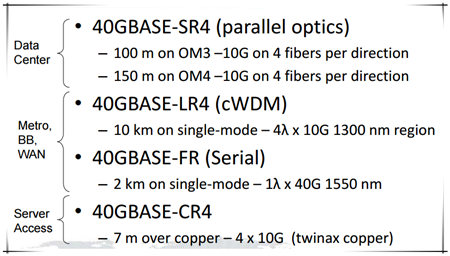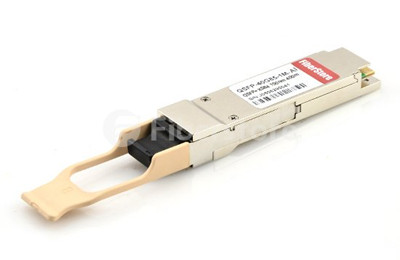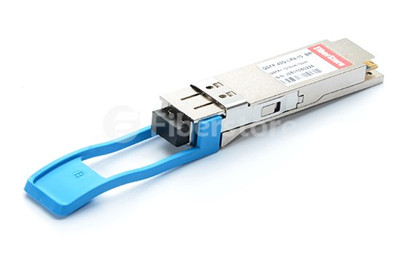Data center regularly went through great migration from 1G, 10G to 40G, 100G over the past few decade. Since IEEE 802.3ba standard defined the 40G Ethernet on June 17, 2010. The newest widely adopted optical transceivers is the QSFP+ that offers aggregated optical speeds of 40G. There are many variants for QSFP+ small from factor including LR4 (10km single-mode), IR4 (2km single-mode) or ESR4 and SR4 for short haul multi-mode. So what are they and what is the difference between them? The following passage will provide a satisfying answer to you.
QSFP optical transceivers have four separate 10G channels to simultaneously operating for supplying 40GbE network and sum up the capacity into a single channel. The following tables shows QSFP40G portfolio, of which 40GBASE-SR4, 40GBASE-LR4 and 40GBASE-ER4 are the most commonly used 40G physical layers.

- 40GBASE-SR4
40GBASE-SR4 (short range) is a port type for multi-mode fiber and uses 850nm lasers. It uses four lanes of multi-mode fiber delivering serialized data at a rate of 10.3125 Gbit/s per lane. 40GBASE-SR4 has a reach of 100m on OM3 and 150m on OM4. There is a longer range variant 40GBASE-ESR4 with a reach of 300m on OM3 and 400m on OM4. This extended reach is equivalent to the reach of 10GBASE-SR. Take JG325A (see in Figure 2) as an example, it is HP compatible 40GBASE-SR4 QSFP+ transceiver. It primarily enables high-bandwidth 40G optical links terminated with MPO multi-fiber connectors and can also be used in a 4x10G module for interoperability with 10GBASE-SR interfaces.

- 40GBASE-ER4
40GBASE-ER4 (extended range) is a port type for single-mode fiber being defined in P802.3bm and uses 1300nm lasers. It uses four wavelengths delivering serialized data at a rate of 10.3125 Gbit/s per wavelength.
- 40GBASE-LR4
40GBASE-LR4 (long range) is a port type for single-mode fiber and uses 1300nm lasers. It uses four wavelengths delivering serialized data at a rate of 10.3125 Gbit/s per wavelength. Take FTL4C1QE1C as an example, it is Finisar FTL4C1QE1C (see in Figure 3) compatible 40GBASE-LR4 QSFP+ transceiver supporting link lengths of 10km at a wavelength of 1310nm.

Comparison of These Three 40GBASE Standards
Through the above definitions of each type of 40G physical layers, you may have a further understanding of them. Now, we are comparing them one by one. 40GBASE-SR4 is for multi-mode fiber while 40GBASE-LR4 and 40GBASE-ER4 is a port type for single-mode fiber. The multi-mode solutions require special MPO fiber ribbons (multi-strand optical cables) to transport the 4 different 10G optical connections. Single-mode solutions use only two strands of fiber and combine the 4 channels using inexpensive CWDM technology. This gives a tremendous advantage, simplifying the connectivity to standard LC optical connectors and thus reducing costs further.
In addition, 40GBASE-LR4 QSFP+ transceivers are most commonly deployed between data-center or IXP sites with single mode fiber. 40GBASE-SR4 QSFP+ transceivers are used in data centers to interconnect two Ethernet switches with 12 lane ribbon OM3/OM4 cables. And from the above figure, we can know that they support different transmission distance in different wavelengths and with different connectors.
Summary
To sum up, 40GBASE-SR4, 40GBASE-LR4 and 40GBASE-ER4 are distinguished with each other in several different features—wavelength, connector, transmission distance, etc. Fiberstore offers a wide variety of high-density and low-power 40GBASE QSFP+ transceiver modules. They are the best-selling products of our company for its large stocks, competitive price and high quality. In addition, there are also a promotion for MTP cables. For more information, please contact us directly.
Reference:
http://www.ieee802.org/3/100GNGOPTX/public/mar12/plenary/cole_01b_0312_NG100GOPTX.pdf
